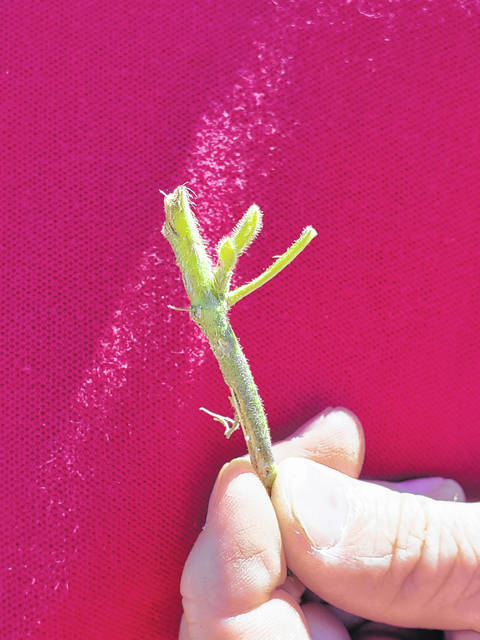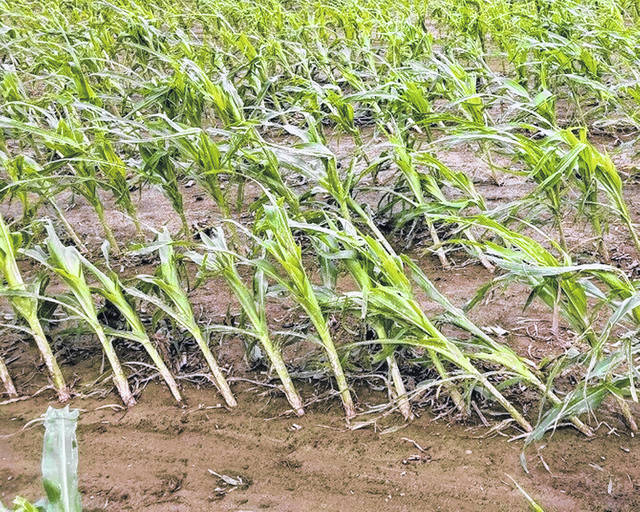


In agriculture, we sometimes live by the weather. The wrath of Mother Nature showed her hand on Friday a week ago and did her share of messing things up in many fields across the county.
Some areas of the county got excessive amounts of rain and this may cause several acres of soybean to be replanted. Other areas received straight-line winds causing lodged corn and wheat in its path, along with bringing many trees down and causing power outages for many.
And then there is the hail damage that came along with the wind — and up to seven inches of rain in a very short period of time.
I have spoken to several producers and looked at many fields, and I can honestly say it could have been worse. Don’t get me wrong, there is plenty of crop damage; but there are a lot of crop acres that will recover and still make a crop.
How much damage is done may not be known until we harvest this fall. Most of the corn that was blown flat is now standing back up, and many of the hail damaged corn and soybean plants are showing new leaves, recovery and potential. (see photos).
These are promising signs for what equates into a very stressful moment. Prayers, patience and lots of good weather will be needed to help these crops recover.
Usually in these types of weather events the most important thing we can do is give it a few days to see how the crops will react to the damage received. It will be interesting to go back next week to fields I visited last week and re-evaluate and assess recovery as well as damage.
Effects on corn
In response to this past week’s severe weather, I decided I would utilize information from a CORN Newsletter Article form 2019 by Peter Thomison, now retired OSU Agronomy Corn specialist.
According to Thomison in this article, the impact of hail damage is largely dependent on corn’s stage of development.
Hail affects yield primarily by reducing stands and defoliating plants. Most of the hail damage results from defoliation. Generally, the corn plant is little affected by hail prior to the 6-leaf collar stage because the growing point is at or below the soil surface and in the leaf whorl.
However, once the growing point is elevated above the soil surface due to internode elongation, the plant grows rapidly and becomes increasingly vulnerable to hail damage with the tassel stage/pollen shedding stage (VT) being the most critical period.
Severe hail damage prior to the 6- to 7-leaf stage can also result in “twisted” or “tied” leaf whorls as injured plants recover and new leaves try to unroll; however, most plants will grow out of this problem and tied whorls seldom cause major yield loss.
Leaf damage by hail usually looks much worse than it really is, especially during the early stages of vegetative growth. Shredded leaves and plants with broken midribs still have some capacity to contribute to plant growth.
Plants not killed outright by hail usually show new growth within 3 to 5 days after injury occurs (i.e. if damage occurs prior to tasseling). For this reason, estimates of hail damage should be delayed several days to allow for this period of re-growth.
The hail insurance adjustor’s growth staging system counts leaves beyond the last visible collar to the uppermost leaf that is 40-50% exposed whose tip points downward — usually this results in a leaf stage that is numerically two leaves greater than the “leaf collar method” (e.g. a V11 plant according to the leaf collar method would probably correspond to a 13-leaf plant according to the hail adjustor’s method).
Much of our corn in the most impacted area is at a young stage of development (V3 to V8). As Thomison notes earlier in this article, most of these plants at this leaf stage/growth stage will grow out of this and little yield loss could be seen.
For soybeans
For soybeans damaged by hail it is imperative to wait to see how they respond. Like with our recent event here in Clinton County, many of us could not have replanted right away because of too much soil moisture.
Before making re-plant decisions, it’s important to do a stand count. Keep in mind, when soybeans are planted in May, a plant population of 100,000 to 120,000 is generally adequate for maximum yield.
At low plant populations, soybean plants adjust by increasing the number of branches. For example, in Wood County in 2015, there was a 14% reduction in soybean yield when plant population was 50,000 plants/acre compared to 100,000 plants/acre.
In the same year in Clark County, soybean yield was reduced by 9% when plant population was 50,000 plants/acre compared to 100,000 plants/acre.
As with any crop damage situation, if you have crop insurance, work with them as I am sure you already are.
Every field will be different on the overall assessment of damage. Take time to walk entire fields to get an accurate assessment of crop condition before making a replant decision. I plan to tour the areas hit the worst again this next week to reevaluate for myself how the crops are responding.
If you would like some assistance in assessing damage/crop recovery from this storm event feel free to contact me at [email protected] or by calling the Clinton County Extension Office at (937) 382-0901.
Tony Nye is the state coordinator for the Ohio State University Extension Small Farm Program and has been an OSU Extension Educator for agriculture and natural resources for over 30 years, currently serving Clinton County and the Miami Valley EERA.




